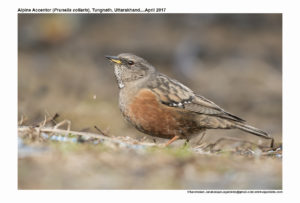Alpine Accentor

Alpine Accentor Prunella collaris
Etymology
- Prunella : Braunelle – German for brown
- Collaris : Latin word for “neck” derived from collum – neck
Vernacular name : Kashmiri : Zanda tsar
Accentor are birds found at high Altitudes. The word Accentor means “Sing together”.
Distribution in India: Alpine Accentor are found at heights of 3000-5000 Ft above mean sea Level. They are Residents of Himalayas.
Description: Size of 15–19 cm; wt. of male 40 g and female 36 g (collaris), male 45 g and female 39g (erythropygia). It is a large, attractive accentor with strong bill, more upright carriage. The nominate race has a grey head and breast, slight black streaking on crown and nape, white throat with black scale-like marks; mantle and back are grey-brown, broadly streaked black, lower back and rump are brownish-grey, more rufescent uppertail-coverts, also streaked black, with pale edges giving scaly appearance. The upperwing are strongly marked, median and greater wing-coverts are black with white tips forming two contrasting spotted wingbars, dark secondaries with pale buff tips forming noticeable wing panel. The tail feathers are dark brown with white tips. The belly is pale grey, breast side and flanks are bright chestnut, becoming more whitish-streaked towards rear; undertail-coverts are dark brown with white feather margins. The iris is brown; bill is blackish, conspicuous yellow base legs are dark pinkish-grey or brown. Both the sexes are alike. The female is slightly smaller than male. The juvenile resembles adult but duller, with unspeckled throat, brownish-grey head and chest, brown breast and flanks. The buff wingbars are less well defined than in adult may be retained by some first-year birds. Races vary in size and colour: race subalpina is similar to nominate, but paler grey on head and chest, less barring on throat, paler upperparts and flanks; race montana is also close to nominate, but crown and neck are olive-grey, streaks on mantle are brown, chestnut on flanks are more extensive, spreading to side of breast and belly and down to undertail-coverts; race rufilata have chestnut below more uniform, with less white streaking; race whymperi has darker head, chest and upperparts, giving stronger contrast with white throat; race nipalensis is darker ; race tibetana is paler, with more white streaking on flanks; race erythropygia has dark head, upperparts and chest combined with deep chestnut uppertail-coverts, scapulars and belly; race fennelli is greyer and less brown on head and chest and paler below .
Habitat: In breeding season, it is found in low cliffs, screes, rocky mountain slopes and alpine meadows above tree-line and up to snow-line; avoids areas of shrubs or trees; often close to snow patches. It breeds exclusively in mountain ranges. It is found at 3600–5000 and observed at almost 8000 m on Mt Everest. Outside breeding season, it is found at lower elevations in rocky and scrubby habitats, often close to human habitation in villages and near livestock, including woodland edges, roadsides, gardens and farms.
Food Habits: It is predominantly a grainivore feeding on Seeds and grains and sometimes on Grass shoots. It also eats small worms to supplement their protein intake. This happens in the breeding season. This gives the incubating parents energy and chicks with protein to grow fast. Also provides the chicks with water content that is absent in Grains and seeds. It forages mainly on ground, among rocks, stones, grass, herbs, moss and lichens; particularly favours melting edges of snow patches. Proceeds with small hops or by walking, and occasionally takes insects in flight; may jump to snatch seeds and berries from low vegetation
Breeding Habits: They breed in May–Aug. They are double-brooded. They have a Polygynandrous mating system, 2–5 males share large overlapping ranges of 2–5 females, .Males compete to mate with fertile females, females compete to attract males. The nest is built by female. The nest is a cup made from grass, moss and plant stems, lined with hair and feathers, sited in rock crevice or beneath rock or grass tussock on cliff or shallower slope. They lay a clutch of 3–4 eggs. The incubation done by female for a period of 11–15 days. The chicks are fed by both sexes